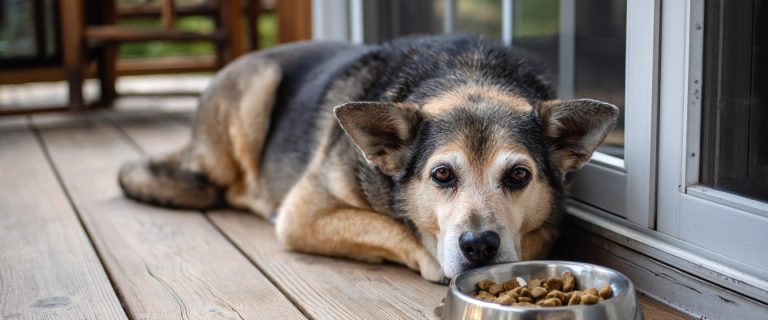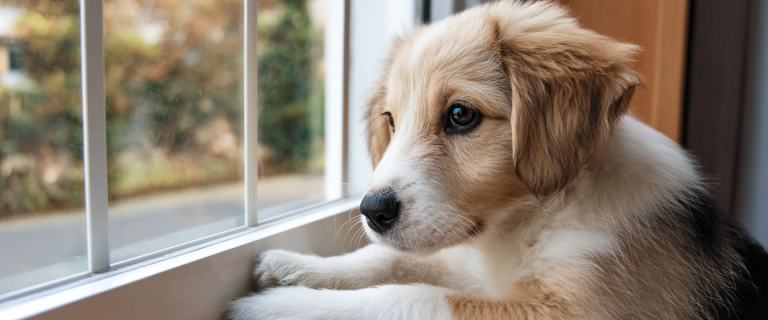What is the Staffordshire Bull Terrier’s lifespan?
With good breeding and proper care, you can expect your Staffie to live from 12 to 14 years.
Want to know more about this “misunderstood” breed?
Read on for the history, health issues and care of the Staffie.
We’ll also give you some key insights into the Bull Terrier temperament and some must-know facts about keeping this breed happy and healthy.
Where Did the Staffordshire Bull Terrier Come From?
The Staffordshire Bull Terrier shares a common genetic link to the Bulldog. For this reason, it is considered to be a part of a larger group of dogs that include the American Staffordshire Terrier, the American Pit Bull Terrier, and the Bull Terrier.
It is thought the Staffie was developed in the 19th century by crossing the Bulldog with the Manchester Terrier. This pooch was intentionally created to be used as a fighting dog that was faster in the ring, yet still friendly towards people. The first Staffordshire Bull Terrier club was formed in England in 1835 where its standards were perfected and written.
When the Staffie made its way to America, it was housed as a family pet. It wasn’t until 1975 that the American Kennel Club recognized the Staffie as a purebred dog. Today, the Staffie ranks 85th (among 157 varieties) for popularity. It is a beloved companion and best friend to all those who have the pleasure of owning one.
Temperament of the Staffordshire Bull Terrier
Are Staffordshire Bull Terriers good family dogs? You bet they are! In fact, Staffies are known for their human-oriented personalities. A well-bred SBT should never be shy or snarly, but rather enthusiastic and outgoing from just a few-weeks-old.
This breed has a tough, courageous, curious and tenacious (leaning towards stubborn) temperament. He loves his family, which makes him a good caretaker, but less likely to protect the property. However, that doesn’t mean he won’t alert you to wanted or unwanted visitors.
Need a pal for your Staffie? Find out What Makes German Shepherds Fantastic Family Dogs?
Staffordshire Bull Terrier Puppy Traits & Training
How big do Staffies get? Depending on your individual puppy’s genetics you can expect a well-bred Staffordshire Bull Terrier to reach from 14 to 16 inches at the withers and from 24 to 38 pounds. Of course, males do tend to be bigger than the females. Before you adopt a Staffie puppy be sure, you are dealing with a reputable breeder. One that has given your potential furry pal early socialization and the proper handling it needs.
A Staffie pup is intelligent and will learn quickly; however, he can also be impulsive and stubborn. A patient, consistent and firm person will be able to develop a strong bond with their SBT. Experts recommend using positive reinforcement over punishment when training the Staffordshire puppy. Harsh corrections can damage your pup’s self-confidence and personality. Use regular training and provide your Staffie with plenty of social interaction to help ensure a well-rounded adult dog. Bored or lonely Staffies tend to be destructive, so be sure to give your puppy plenty of things to do.
When it comes to housetraining the SBT, you will be happy to know that it comes relatively easily to the breed. Some pet parents have found that using a crate and sticking to a schedule are both beneficial to potty training the Staffie puppy. A crate is also an excellent place for your puppy (and adult dog) to “get away from it all.” So never use it as a punishment. With proper training and early socialization, your SBT puppy will become a loyal and happy family companion.
Get the help you need to train your SBT with our ultimate pit bull puppy training tips!
Quick Facts About the Staffordshire Bull Terrier
- Height: 14 to 16 inches at the shoulder
- Weight: 24 to 38 pounds
- Dog Breed Group: Terrier
- Hypoallergenic: No
- Lifespan: 12 to 14 years-old
Care of the Staffordshire Bull Terrier
Since the Staffordshire Bull Terrier is a strong, muscular dog, you will want to start him off right by choosing a high quality, nutritional diet. The kibble should include an identified protein as the first ingredient followed by vegetable, fruits and added vitamins and minerals. Read the dog food ingredient labels to find one that will suit your Staffie’s needs. Experts recommend dividing your SBT daily food intake into two portions to avoid bloat (more on that later).
Can a Staffy live in an apartment, what are his exercise requirements? Even though not all small dogs are automatically a good fit for apartment living, the Staffie’s quiet nature and need to live indoors makes him suitable for condo or apartment dwelling.
Your SBT will need daily exercise but be aware of the temperature. The Staffordshire’s short muzzle can prove to be a problem on very hot and humid days. This breed also does not do well in extreme cold.
If your Staffie has access to a backyard, be aware that the breed does have a propensity to dig. Reinforcing the fence by solidifying it in concrete or burying chicken wire beneath it will both foil your Staffie’s escape plan.
Some SBTs do love swimming, so pet parents may want to provide their fur baby with a kiddie pool. However, due to their physical makeup, you will want to take precautions that your pooch does not fall into an adult pool as they are not good swimmers.
Grooming Your Staffordshire Bull Terrier
The Staffie’s short coat is relatively easy to maintain. You can expect heavier shedding annually, with less hair loss throughout the year. The nice thing about this breed’s coat is the dirt tends to brush out quite easily, and the coat dries quickly after a bath – basically a wash-and-wear. The Staffie breed tends not to carry around odors, so bathing once-a-month is most likely all it will need.
Other grooming needs include daily dental hygiene and nail care. Teeth brushing and dental chews can help reduce plaque and tartar buildup while trimming those nails can be done as needed.
You will also want to check your pet’s ears for any redness, debris or inflammation. To help keep the ears clean, use a cotton ball and cleanser (made for dogs) and gently wipe clean as needed.
Starting a grooming routine with your Staffie should be done when he is a puppy so he will get used to the procedures.
Health Issues of the Staffordshire Bull Terrier
Even though the SBT is a relatively healthy breed, there are still some Staffy health problems that can occur. These include;
- Canine Hip Dysplasia (CHD). This is a heritable condition where the thigh bone doesn’t fit snugly into the hip joint. This can eventually cause lameness or arthritis. An X-ray screening for hip dysplasia can be done by your veterinarian. Those dogs that test positive for this genetic disorder should not be bred.
- Elbow Dysplasia: Another genetic condition affecting the SBT is Elbow Dysplasia. This illness is thought to be caused by different growth rates of the three bones that make up the dog’s elbow, which causes the joint to become loose. This can lead to painful lameness. Depending on the severity, your vet may recommend surgery, weight management, or medication to control the pain.
- Patellar Luxation: This common problem occurs when the patella (consisting of the femur (thigh bone), patella (kneecap), and tibia (calf)) are not properly lined up. When this occurs, they can easily slip out of place. The rubbing caused by patellar luxation can lead to arthritis.
- Hereditary Juvenile Cataracts: This condition is characterized by the development of opacity or cloudiness in the lens of the eye. It can progress relatively quickly, which can lead to blindness by the age of three. Surgery can sometimes partially restore vision.
- L-2 Hydroxyglutaric Aciduria: A genetic condition that leaves the canine without the proper enzyme to break down the L-2 Hydroxyglutaric Aciduria compound.
- Skin Allergies: This itchy, scratchy condition is sometimes seen in certain Staffies. The problem is often compounded by bacterial infections. Supplementing your dog with omega-3 compounds or aggressive flea control treatments have been known to help.
- Demodectic Mange: All dogs carry Demodex mites, which live in hair follicles. They usually don’t cause any problems, but dogs with weakened or compromised immune systems can develop a condition called demodectic mange. It can form patches of red, scaly skin with hair loss appearing on the head, neck, and forelegs.
- Bloat: Also known as “twisted stomach” occurs when your Staffie has eaten a large portion of food, then vigorously exercises shortly afterward. This action causes the stomach to flip over on itself, cutting off circulation. Left untreated this condition can lead to death.
Although these genetic issues can affect the Staffordshire Bull Terrier, there’s one Staffie that is defying the odds. Her name is Tara, and she is a whopping 18 years-old – that’s 126 in doggie years – making her possibly the oldest Staffie in the UK. Her pet parents, Tom and Sandra Pegg have had Tara since she was eight-weeks-old and credit her longevity to “lots of love.”
The Staffordshire Bull Terrier is a trustworthy pooch that loves to be with his human companions. He makes a good family pet as long as STB puppies have good breeding and early socialization. As with any dog breed, be sure you are the right type of pet parent for the Staffordshire Bull Terrier. Patience, training and lots of praise are key to having a good bond with the Staffie pooch.
Before you adopt a Staffie, research out reputable breeders to ensure you can avoid the number of genetic issues that are linked to the SBT.
If you are a pet parent to a Staffordshire Bull Terrier, then feel free to drop us a line in the comment section. We love to hear from folks that have first-paw knowledge!



